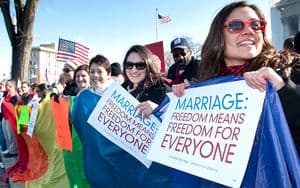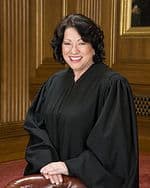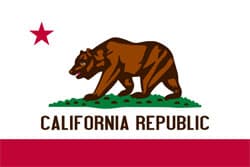
 The freedom to marry will soon return to California thanks to the Supreme Court's decision that the Prop 8 proponents lacked the right to appeal Judge Vaughn Walker's original decision declaring Prop 8 unconstitional.
The freedom to marry will soon return to California thanks to the Supreme Court's decision that the Prop 8 proponents lacked the right to appeal Judge Vaughn Walker's original decision declaring Prop 8 unconstitional.
This opinion looks simple, but it's a bit of a surprising line up of judges, with the Chief Justice writing the opinion and being joined by Justices Scalia, Ginsburg, Breyer, and Kagan. The dissenters include Justice Kennedy (who wrote the dissent) and Justices Thomas, Alito, and Sotomayor.
At issue in this case is whether ordinary citizens have the right to defend in federal court the ballot initiative they wrote. But the disagreement between the majority and dissent is a little more arcane, concerning who gets to decide. The dissenters were content with the decision of the California Supreme Court, which broadly defined that state's initiative law to include initiative proponents' power to appeal an adverse ruling on their ballot measure. The majority, quite correctly, was having none of that. Federal standing is a matter of federal law, and no manner of state supreme court can say otherwise.
As a practical matter, this means that marriage will soon return to California. Not immediately, mind you; if you recall, Judge Walker's initial order requiring the issuance of marriage licenses to gay couples was stayed, first by him and then by the Ninth Circuit in an order separate from its substantive decision in Perry v. Brown. Going forward, a decision on standing means that if we want the Supreme Court to weigh in on a nationwide freedom to marry, we're going to need another case.
CONTINUED, AFTER THE JUMP…
Here are my initial takeaways from the Court's opinion in Hollingsworth v. Perry.
 1. The Law: The majority stays close to traditional federal standing rules. The dissent does not.
1. The Law: The majority stays close to traditional federal standing rules. The dissent does not.
Traditionally, a litigant trying to get into the federal courts and one trying to appeal a federal decision has to be seeking a remedy for a "personal and tangible harm." A valid federal case also has to be a live argument all the time: there have to be two sides disagreeing about an ongoing controversy.
There was no issue starting the case. The plaintiffs wanted to get married; the State of California had a law — Prop 8 — that prevented them from doing so. There also would not have been a problem had California wanted to defend Prop 8: Judge Walker's decision to require issuance of marriage licenses was a direct "injury" to the State. But California backed out, leaving only the Prop 8 Proponents, who got involved in the case but did not necessarily have to.
As ordinary citizens, they only have a "generalized grievance" — I want my law enforced! — and no direct harm came to them from the invalidation of Prop 8 at the district court. After all, they weren't the ones to have to issue licenses; the State of California was. They had no personal stake in the litigation other than what may very well be a deeply held belief in keeping gays away from marriage.
The Court splits, then, on the view of the effects of the California Supreme Court decision on standing. If you recall, the Ninth Circuit asked the California Supreme Court to determine if, as a matter of state law, the power to propose and enact a ballot initiative includes a right to defend that law in court. The California Supreme Court said yes, and the dissent relies heavily on the state court's argument that the power to "propose and enact" would mean nothing without the power to "defend."
But the dissent misses the point that regardless of what a state court says about state law, you cannot get into the federal courts without particularized interest. Plus, once a ballot initiative becomes a law, it is a law like any other law, whether passed by the legislature or passed by the people. If random citizens do not have the power to defend a law passed by the legislature, then how can they have to the power to defend a law that happened to passed by the people. A law is a law is a law.
 2. The Line-Up: There have already been quite a few questions swirling about the unexpected line up of the judges. I think the questions are a little misplaced, though questions remain for further research.
2. The Line-Up: There have already been quite a few questions swirling about the unexpected line up of the judges. I think the questions are a little misplaced, though questions remain for further research.
Justice Scalia has a long history of narrowing standing rules to restrict access to the federal courts. The Chief Justice, as a younger judge, has a shorter history, but comes from the same intellectual tradition. It should come as no surprise, then, they both of them are on the side of limiting standing in this case. Justice Breyer, a moderate if there ever was one, is a bit of a wild card, so I'm never surprised to see him join his more conservative colleagues on occasion.
The Twitterverse is questioning how Justice Sotomayor ended up separated from her liberal colleagues. Whereas she joined the dissent, Justices Ginsburg and Kagan joined the majority against standing. It occurs to me that perhaps Justices Ginsburg's and Kagan's positions (and, conversely, Justices Thomas's and Alito's) are the ones that require explanation, not Justice Sotomayor's.
There are numerous explanations. The easiest is politics. Perhaps Justice Sotomayor wanted to reach the merits and is not going to put formalist rules over substantive fairness. And perhaps Justices Ginsburg and Kagan were more uncertain about the fate of marriage at their Court and did not want to risk a negative decision that could set back our cause. Justice Thomas has shown a great willingness to dispense with ideology to achieve his radical conservative goals, so maybe he wanted to reach the merits that Ginsburg and Kagan feared. These are, of course, pure speculations.
I will do some research into the justices's past decisions on standing and jurisdiction to see if I can find a pattern.
 3. The Effect: Marriage will soon return to California, but if we continue with a federal litigation strategy for a national right to marry, we should look to other cases in the federal courts.
3. The Effect: Marriage will soon return to California, but if we continue with a federal litigation strategy for a national right to marry, we should look to other cases in the federal courts.
Substantively, we lose the Ninth Circuit's opinion. Because the Prop 8 proponents never had the right to be there in the first place, that decision fails the jurisdictional requirements for valid federal cases. I had serious doubts about the intellectual and legal weight of that decision, but it nevertheless was the first federal appellate court decision to declare unconstitutional a ban on the freedom to marry. The greater precedential effect of that cannot be understated. Now, we have to start again with some of the other marriages cases winding their way through the courts.
California will soon become the 13th state to have the freedom to marry. The thing is, it had it before; it finally has it again. But before any of our friends in California can get married, the stay that has been holding back Judge Walker's decision has to be lifted. It is my understanding that the Supreme Court decision will take effect in 25 days. The stay, which was put in place first by Judge Walker and then by the Ninth Circuit, would be lifted after that.
***
Follow me on Twitter: @ariezrawaldman
Ari Ezra Waldman is the Associate Director of the Institute for Information Law and Policy and a professor at New York Law School and is concurrently getting his PhD at Columbia University in New York City. He is a 2002 graduate of Harvard College and a 2005 graduate of Harvard Law School. Ari writes weekly posts on law and various LGBT issues



